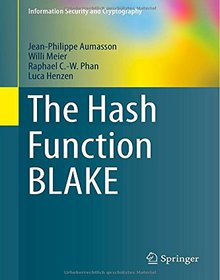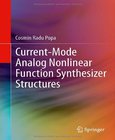The Hash Function BLAKE

Book Details:
| Publisher: | Springer |
| Series: | Springer |
| Author: | Jean-Philippe Aumasson |
| Edition: | 1 |
| ISBN-10: | 3662447568 |
| ISBN-13: | 9783662447567 |
| Pages: | 228 |
| Published: | Jan 09 2015 |
| Posted: | Sep 22 2015 |
| Language: | English |
| Book format: | |
| Book size: | 2.03 MB |
Book Description:
This is a comprehensive description of the cryptographic hash function BLAKE, one of the five final contenders in the NIST SHA3 competition, and of BLAKE2, an improved version popular among developers. It describes how BLAKE was designed and why BLAKE2 was developed, and it offers guidelines on implementing and using BLAKE, with a focus on software implementation.In the first two chapters, the authors offer a short introduction to cryptographic hashing, the SHA3 competition and BLAKE. They review applications of cryptographic hashing, they describe some basic notions such as security definitions and state-of-the-art collision search methods and they present SHA1, SHA2 and the SHA3 finalists. In the chapters that follow, the authors give a complete description of the four instances BLAKE-256, BLAKE-512, BLAKE-224 and BLAKE-384; they describe applications of BLAKE, including simple hashing with or without a salt and HMAC and PBKDF2 constructions; they review implementation techniques, from portable C and Python to AVR assembly and vectorized code using SIMD CPU instructions; they describe BLAKEs properties with respect to hardware design for implementation in ASICs or FPGAs; they explain BLAKE's design rationale in detail, from NISTs requirements to the choice of internal parameters; they summarize the known security properties of BLAKE and describe the best attacks on reduced or modified variants; and they present BLAKE2, the successor of BLAKE, starting with motivations and also covering its performance and security aspects. The book concludes with detailed test vectors, a reference portable C implementation of BLAKE, and a list of third-party software implementations of BLAKE and BLAKE2.The book is oriented towards practice engineering and craftsmanship rather than theory. It is suitable for developers, engineers and security professionals engaged with BLAKE and cryptographic hashing in general and for applied cryptography researchers and students who need a consolidated reference and a detailed description of the design process, or guidelines on how to design a cryptographic algorithm.
Download Link:
Related Books:
Analog and Digital Control System Design
Transfer-Function, State-Space, and Algebraic Methods
This text's contemporary approach focuses on the concepts of linear control systems, rather than computational mechanics. Straightforward coverage includes an integrated treatment of both classical and modern control system methods. The text emphasizes design with discussions of problem formulation, design criteria, physical constraints, several design methods, and implementation of compensators. Discussions of topics not found in other texts--such as pole placement, model matching and robust tracking--add to the text's cutting-edge presentation. Students will appreciate the applications and discussions of practical aspects, including the leading problem in developing block diagrams, noise, disturbances, and plant perturbations. State feedback and st...
Engineering Secure Two-Party Computation Protocols
Design, Optimization and Applications of Efficient Secure Function Evaluation
Secure two-party computation, called secure function evaluation (SFE), enables two mutually mistrusting parties, the client and server, to evaluate an arbitrary function on their respective private inputs while revealing nothing but the result. Originally the technique was considered to be too inefficient for practical privacy-preserving applications, but in recent years rapid speed-up in computers and communication networks, algorithmic improvements, automatic generation, and optimizations have enabled their application in many scenarios.The author offers an extensive overview of the most practical and efficient modern techniques used in the design and implementation of secure computation and related protocols. After an introduction that sets secure...
Current-Mode Analog Nonlinear Function Synthesizer Structures
This book is dedicated to the analysis and design of analog CMOS nonlinear function synthesizer structures, based on original superior-order approximation functions. A variety of analog function synthesizer structures are discussed, based on accurate approximation functions. Readers will be enabled to implement numerous circuit functions with applications in analog signal processing, including exponential, Gaussian or hyperbolic functions. Generalizing the methods for obtaining these particular functions, the author analyzes superior-order approximation functions, which represent the core for developing CMOS analog nonlinear function synthesizers....
2007 - 2021 © eBooks-IT.org



